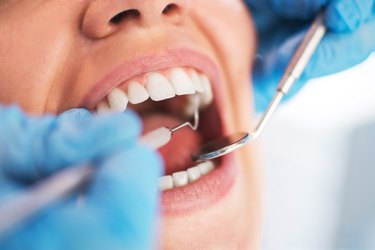

The Refresh is helping you freshen up on your oral-care knowledge and upgrade your dental-hygiene routine.
When it comes to your teeth, calcium is usually a good thing. Calcium deposits? Not so much.
Calcium deposits — also referred to as tartar or calculus (yes, like the math) — are formed from plaque that has hardened, or "mineralized," on the teeth. Plaque is a colorless, sticky film that contains bacteria.
Video of the Day
Video of the Day
Everyone has plaque on their teeth, although some of us have more than others. Brushing your teeth regularly — as well as cleaning in between your teeth with dental floss, for example — helps prevent plaque from hardening into tartar.
Here's what you should know about calcium deposits, including what causes them, how to treat them and prevention tips.
Signs and Symptoms
One quick way to determine if you have plaque on your teeth is by running your tongue along your teeth — if they feel "fuzzy," that's a sign of plaque.
Some signs and symptoms of tartar can include:
- Chronic bad breath (halitosis)
- Cavities
- Red, swollen gums (gum disease, also known as gingivitis)
Sometimes, however, tartar is "silent," and doesn't have any noticeable symptoms, says dentist Tricia Quartey-Sagaille, DMD, a spokesperson for the American Dental Association (ADA). It can also appear in hard-to-reach places like the back of the bottom teeth, where people can't see it.
Tartar that builds up can "inflame and irritate the gums and start to destruct the tissue, fiber and bone that supports the teeth," she says. If tartar isn't removed, it can eventually lead to:
- Cavities
- Gum disease
- Gum infection (periodontitis)
- Loose teeth
- Tooth loss
- Tooth infection (abscess)

Causes
Everyone has bacteria in their mouth that can cause plaque. After you eat or drink something, the bacteria in your mouth go to work breaking down carbohydrates, and in the process produce acids that attack the outer layer of your teeth (the enamel) — something that can result in cavities.
Plaque forms when a film containing this bacteria collects on the teeth; if the plaque isn't removed with regular brushing or flossing (or another form of cleaning between the teeth), it can harden into tartar, or calcium deposits, says Dr. Quartey-Sagaille.
Ultimately, plaque hardens at different rates in different people — in part because everyone has different saliva, she explains. But for most people, "plaque starts to harden in a day or two."
Some people may be more likely to develop plaque than others, according to the Cleveland Clinic. Rick factors include:
- Smoking
- Eating a lot of sugar or starchy foods
- Having dry mouth, which can be caused by conditions like Sjogren's syndrome
- Undergoing radiation
- Taking medications like antidepressants
Treatment
Unlike calcium deposits in the body, calcium deposits on teeth can't be removed at home — they can only be removed by a dental professional, like a dentist or dental hygienist, who will use specific dental instruments to remove the tartar, says Dr. Quartey-Sagaille.
"This is a big defining factor between plaque and tartar," she says. You can remove plaque at home by regular brushing and flossing, she explains, whereas you can't remove tartar yourself.
To remove calcium deposits, a dentist will perform the following procedures:
- Scaling: A procedure in which a dentist uses a special hand instrument, called a scaler, or an ultrasonic scaler called a cavitron (which uses vibrations and water), to remove the tartar, she says.
- Scaling and root planing: If there's a lot of tartar on the teeth, a dentist will remove the tartar above and below the gumline. Then they will begin root planing — a process of creating a smooth surface to prevent the accumulation of more tartar, she says.
It's important to schedule regular appointments with your dentist, who can remove calcium deposits in the dental office. If left untreated, tartar can cause problems such as gum disease or tooth loss.
Prevention
The best way to prevent calcium deposits from forming is by preventing plaque from collecting on your teeth. Here are a few ways to do that:
- Brush your teeth regularly: The ADA recommends brushing your teeth for two minutes at a time, twice a day, with a soft-bristled toothbrush and a fluoride toothpaste. It's a good idea to replace your toothbrush every three or four months, or whenever the bristles start to fray, because it won't be as effective at cleaning your teeth.
- Clean between your teeth: Regular toothbrushing won't remove all the plaque between your teeth, Dr. Quartey-Sagaille says. For that, you'll need to clean between your teeth, where a brush can't reach, with a tool like dental floss or a water flosser.
- Chew sugarless gum: Chewing sugarless gum can help remove food particles from your teeth after you eat, she says.
- Drink plenty of water: Staying hydrated helps wash away bacteria before they build up on your teeth.
- Use a mouthwash: If you accumulate plaque quickly, you may want to rinse with a mouthwash that contains fluoride to remove food particles from your teeth, Dr. Quartey-Sagaille says.
- Schedule regular dental appointments: Your dentist can remove plaque or any tartar that has built up on your teeth. Talk to your dentist about how often you need to come in — the ADA says that some people may need to see their dentist once or twice a year, whereas others may require more regular appointments.
Is this an emergency? If you are experiencing serious medical symptoms, please see the National Library of Medicine’s list of signs you need emergency medical attention or call 911.



